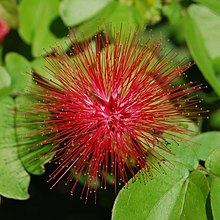Loading AI tools
Subfamily of legumes From Wikipedia, the free encyclopedia
The Mimosoideae are a traditional subfamily of trees, herbs, lianas, and shrubs in the pea family (Fabaceae) that mostly grow in tropical and subtropical climates. They are typically characterized by having radially symmetric flowers, with petals that are twice divided (valvate) in bud and with numerous showy, prominent stamens.
| Mimosoideae | |
|---|---|
 | |
| Calliandra emarginata | |
| Scientific classification | |
| Kingdom: | Plantae |
| Clade: | Tracheophytes |
| Clade: | Angiosperms |
| Clade: | Eudicots |
| Clade: | Rosids |
| Order: | Fabales |
| Family: | Fabaceae |
| Subfamily: | Caesalpinioideae |
| Clade: | Mimosoid clade DC. |
| Informal groups | |
|
See text | |
 | |
| Distribution of the Mimosoideae | |
| Synonyms | |
| |
Recent work on phylogenetic relationships has found that the Mimosoideae form a clade nested with subfamily Caesalpinioideae and the most recent classification by The Legume Phylogeny Working Group refer to them as the Mimosoid clade within subfamily Caesalpinioideae.[1] The group includes about 40 genera and 2,500 species.
Some classification systems, for example the Cronquist system, treat the Fabaceae in a narrow sense, raising the Mimisoideae to the rank of family as Mimosaceae. The Angiosperm Phylogeny Group treats Fabaceae in the broad sense. The Mimosoideae were historically subdivided into four tribes (Acacieae, Ingeae, Mimoseae, and Mimozygantheae). However, modern molecular phylogenetics has shown that these groupings were artificial. Several informal subgroups have been proposed, but not yet described formally as tribes.[2][3][4][5][6][7] Additionally, the genus Acacia was recently segregated into five genera (Acacia sensu stricto, Acaciella, Mariosousa, Senegalia, and Vachellia).[8][9]

The following fossil wood morphogenera have been described:[21][22]
Modern molecular phylogenetics suggests the following relationships:[23][24][25][26][27][28][29][18]
| ||||||||||||||||||||||||||||||||||||||||||||||||||||||||||||||||||||||||||||||||||||||||||||||||||||||||||||||||

Acacieae (Dumort., 1829[30]) is a wide-ranging, polyphyletic tribe of legumes in the Mimosoideae[31] that is native to the tropics, subtropics, and warm-temperate regions. It includes five or six genera and some 1,450 species.
In Bentham's 1842 circumscription of the subfamily Mimosoideae, Acacieae was one of its three constituent tribes, the others being Ingeae Benth. & Hook.f. and Mimoseae Bornn.[32] His Acacieae tribe of 1842 included many genera that were subsequently assigned to tribe Ingeae Benth. In 1875, however, Bentham narrowed his definition of Acacieae so as to include only Acacia Mill.[33]
The only morphological character of Acacieae used to distinguish it from the Ingeae is the presence of free stamens (as in tribe Mimoseae).[32] In the Ingeae they are fused in the form of a tube, whereas in the Acacieae only a few species have the stamens fused at the base. Several characters of the foliage, seeds, seed pods, pollen, and stipules are shared by the two tribes.[32] The flower morphology of Acacia s.l. has characteristics in common with the genera Leucaena, Piptadenia, and Mimosa (tribe Mimoseae) and Enterolobium and Lysiloma (tribe Ingeae).[34]
The tribal position of monotypic genus Faidherbia A. Chevalier is equivocal.[31] It was included in the Acacieae by Vassal (1981) and Maslin et al. (2003), but Lewis & Rico Arce placed it in tribe Ingeae following Polhill (1994) and Luckow et al. (2003).[31][35] In the latter case, tribe Acacieae may conform to genus Acacia s.l., pending the latter's relationship to other mimosoid genera. Faidherbia is troublesome as its stamens are shortly united at their base and its pollen is similar to some taxa in the Ingeae.[33]
They are trees, shrubs or lianas, which may be armed or unarmed.[36] Where they have spines, these are modified stipules. In some, prickles arise from the stem's cortex and epidermis.[37] The leaves are bipinnate or are modified to vertically oriented phyllodes. A few have cladodes rather than leaves.[38] Extrafloral nectaries may be present on the petiole and rachis, and the pinnule tips may carry protein-lipid Beltian bodies.[37] The leaflets are usually opposite, and are carried on shortly stalks or are sessile. The heartwood is typically red and hard,[39] and the sap of various species hardens into gum.[38]
The inflorescences are dense pedunculate heads or spikes borne in axillary clusters, or are aggregated in terminal panicles.[36] The tetra- or pentamerous flowers are uniformly bisexual, or male and bisexual. Sepals are connate (i.e. fused) and valvate (i.e. not overlapping). The reduced petals are valvate, or rarely absent. The flowers have numerous exserted (i.e. protruding) stamens (>2× as many as the corolla lobes),[34] and their filaments are sometimes connate at their base (forming a short stemonozone). Male flowers of some Neotropical species have a reduced staminal tube (cf. A. albicorticata, A. hindsii, A. farnesiana, and S. picachensis).[34] Flowers are usually yellow or cream-coloured, but may be white, red, or purple.[38]
The ovary is sessile or stipitate (i.e. supported by a stipe), with many ovules or ovules arranged in two rows. The ovary is attached by a filiform style to a small, capitate stigma. The legume's endocarp is attached to the exocarp, but is otherwise very variable, and may be dehiscent or indehiscent. Seeds are usually elliptic to oblong and flattened to varying degrees. Seeds have a hard black-brown testa (i.e. seed coat) with a pleurogram, visible as a closed or almost closed O-shaped line. Some phyllodinous species have a colourful aril or elaiosome on the seed.[36]
Seamless Wikipedia browsing. On steroids.
Every time you click a link to Wikipedia, Wiktionary or Wikiquote in your browser's search results, it will show the modern Wikiwand interface.
Wikiwand extension is a five stars, simple, with minimum permission required to keep your browsing private, safe and transparent.